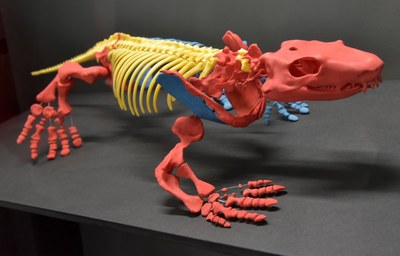From fossil to robot and back again
I
Mounted skeleton on the basis of the virtual 3D reconstruction
Photo: Felix Sattler, HU Berlin
In collaboration between the Ècole Polytechnique Fédérale de Lausanne (EPFL) and the Humboldt-Universität zu Berlin (HU), an international research team has researched into the movement of an early land vertebrate. The innovative research into uncertainty factors as part of the simulation study, as well as creation of a robot replica of the Fossil set methodological standards and allows for new insights into the biology of the ancient fossil.
The study was published in the journal nature. A 3D reconstruction of the vertebrate fossil should be on display from the end of 2019 in the exhibition of the HU at the Humboldt Forum.
New findings through reconstruction of movement
John Nyakatura, lead author and zoologist from the excellence cluster “Interdisciplinary Laboratory Image Knowledge Gestaltung. " of the HU, in close cooperation with the "Biorobotics Laboratory” of the EPFL, investigated the movement of the almost 300-million-year-old vertebrate fossil, Orobates pabsti. In addition, researchers and scientists from Jena, Hamburg and London were involved. In a decisive step of the study, a biomimetic walking machine was built by the Swiss Biorobotics Laboratory, OroBOT, which incorporates many properties of the fossil. The robot demonstrates simulated movement patterns and is able to reproduce the tracks made by the fossil, Orobates.
Using the robot, different movement patterns could be tested systematically and evaluated in terms of their plausibility. All of the associated data were published together with the results.
Orobates pabsti is regarded as a key fossil for understanding the evolution of land vertebrates. It acts as an early representative from a successful line of amniotes, which led to our modern-day mammals, reptiles (including all extinct dinosaurs), and birds. On the basis of the reconstructed movements, the study was able to investigate into whether Orobates was already capable of effectively moving around on land, an ability that to-date was assumed to be reserved to later amniotes. This hypothesis was supported by the new study, such that the crucial step of independence from water must now be accepted as occurring a few million years earlier.
Prof. Dr. John Nyakatura, lead author and zoologist at the HU:
“Using high-speed X-ray video and force measurements of different lizards and salamanders, we were initially able to investigate the principles of movement mechanics behind the reptilian-type gait. Mechanical properties that are shared by all animals living today could be used as the basis for reconstruction of the movement of the fossil".
Successful research results through cooperation between the universities
Investigation of living animals was carried out at the Institute of Zoology and Evolutionary Biology at the University of Jena where rare high-tech facilities are available. A detailed 3D model of the fossilised skeleton was animated based on the movement principles of modern-day animals that had already been researched, in cooperation with the Hamburg-based science illustrators, Jonas Lauströer and Amir Andikfar, in such a way that the model could walk in the tracks set out by the fossil. “This animation is not a complete idea for the movement, but rather on the contrary, a novel research tool that allows us to systematically play through different variables relating to movement and to assess their plausibility", explains Nyakatura. The intensive cooperation between design disciplines and sciences is a programme born from the Berlin Cluster of Excellence as well as from the research by Prof. Nyakatura at the HU.
Further findings to allow for assessment of the plausibility of the fossil-based movement reconstruction were produced by a dynamic simulation. Scientists at the Biorobotics Group in Lausanne optimised the movement sequence in terms of criteria that can still be seen in modern-day animals.
The data investigated can be explored on an interactive website released alongside the study on 16 January, from 19h00, making these effects on movement accessible to interested users.
Further information
Reference to the study: Nyakatura, JA et al. 2019. Reverse- engineering the locomotion of a stem amniote. Nature 565, 351–355
Link to original publication: http://dx.doi.org/10.1038/s41586-018-0851-2
 Information about the study, including a "media kit" on the website of the École Polytechnique Fédérale de Lausanne – EPFL, Switzerland
Information about the study, including a "media kit" on the website of the École Polytechnique Fédérale de Lausanne – EPFL, Switzerland
Link to the interactive website of the study
Contact
Prof. Dr. John Nyakatura
Institute of Biology / Interdisciplinary laboratory Image Knowledge Gestaltung
Tel.: 030 2093-6726
john.nyakatura@hu-berlin.de
http://www.nyakaturalab.com/
Dr. Kamilo Melo
Biorobotics Laboratory
École Polytechnique Fédérale de Lausanne – EPFL, Switzerland
EPFL-STI-BIOROB MED 1 1024, Lausanne CH-1015, Switzerland
Tel.: +41-797179371
kamilo.melo@epfl.ch
Jens Wagner
press officer
Tel.: 030 2093-2275/-12859
jens.wagner@hu-berlin.de
The following institutions were involved in the study:
- Institute of Biology, Humboldt University of Berlin [Humboldt Universität zu Berlin], Berlin, Germany.
- Bild Wissen Gestaltung. An interdisciplinary lab, Humboldt University of Berlin [Humboldt Universität zu Berlin], Berlin, Germany.
- Biorobotics Laboratory, École Polytechnique Fédérale de Lausanne (EPFL), Lausanne, Switzerland.
- Structure & Motion Laboratory, Department of Comparative Biomedical Sciences, The Royal Veterinary College, North Mymms, UK.
- Faculty of Design, Media and Information [Fakultät Design, Medien und Information], Department of Design, University of Applied Sciences [Hochschule für Angewandte Wissenschaften], Hamburg, Germany.
- Institute of Zoology and Evolutionary Research with ‘Phyletische’ Museum [Institut für Zoologie und Evolutionsforschung mit Phyletischem Museum], Ernst-Haeckel-Haus und Biologiedidaktik, Friedrich-Schiller-Universität Jena, Jena, Germany
- Knowledge Visualisation, Zurich University of the Arts [Zürcher Hochschule der Künste], Zurich, Switzerland.
